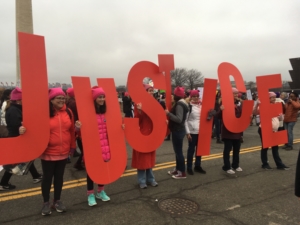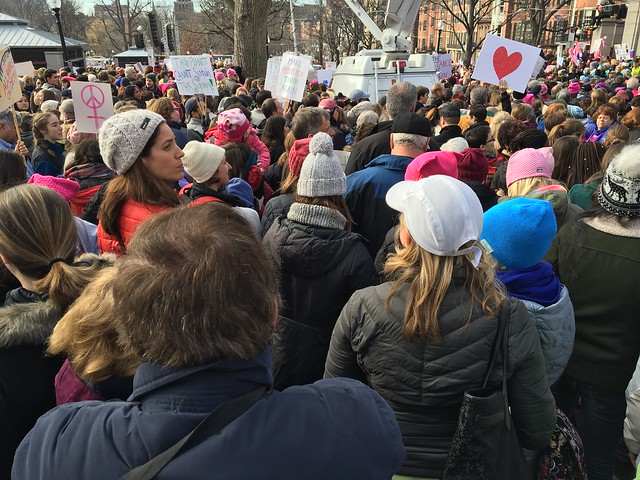Women’s March: DHS students and alumni march in D.C., Sacramento, Oakland
By Isabella Ainsworth,
BlueDevilHUB.com Editor-in-Chief–
Hundreds of thousands of people participated in the Women’s March on Washington and its offshoots around the country the day after Donald Trump was sworn in as the 45th president of the United States.
IN THE DISTRICT OF COLUMBIA
For senior Lucy Shauman, the decision to participate was simple. She booked tickets to D.C. to go to the march with her mother almost as soon as she heard about the march’s existence, just after the election.
“The fact that Trump was elected and that the partial rights women have are now in jeopardy was a big factor in my decision,” Shauman said.
Although they got to D.C. the day of the inauguration, they did not go to see any of the festivities. As Shauman described it, they “boycotted” it.
Bright and early next morning, however, Shauman was out in D.C. She used the metro to get to the march, even though it was so crowded it was “insane.” It was still crowded when they actually got to the streets.
“It was so packed when we started marching we didn’t even move,” Shauman said.
Shauman spent a full day, from 9 a.m. to 5 p.m., on the streets. The march, for her, was a way to remind Donald Trump, and the rest of the United States, that “women are still struggling for the most basic of rights and that we will not stand down until we have full equality.”
She was also there to support other groups of people who feel threatened under the Trump administration.
Although today’s event was Shauman’s first experience with marching and protesting, many of the men and women in the crowd were veterans.
“I came across multiple people who remembered fighting for the same rights thirty years ago and expressed their frustration that women still have to demand the most basic of rights,” Shauman said.
Not everyone in the “Women’s March on Washington” was female, though. Senior Varun Kota, Davis High Class of 2016 and a freshman at Georgetown University, also attended the march.
Although Kota conceded that some men might have been turned off by the name of the event, he personally thought that the “name was fine because we were, of course, fighting for women’s rights.”
Many of the men he knows at Georgetown also attended the event. For Kota, the march was an opportunity both to uphold women’s rights and to send a message to Trump.
“I believed that it was important to attend the Women’s March in D. C. in order to send a very visible signal to President Trump that I–and millions of other Americans–am not okay with the way he has treated women,” Kota said.
Kota was there from 9 a.m. to 3 p.m. He said organizers of the event handed out signs with slogans like “We are the noisy majority!” and “Respect women of color.” There was a diverse array of chants and slogans at the march, including “Hey, hey, ho, ho, misogyny has got to go!” and “Black lives matter!” One woman at the march was dressed like Lady Liberty, complete with green body paint, a robe, stone tables and a fake torch.
Although there were many notable speakers at the event including Angela Davis, Scarlett Johansson and California senator Kamala Harris, Kota could not hear much of their speeches because they were not loud enough. He did, however, see John Kerry and Katy Perry walk past on their way to speak.
It was a uplifting experience for Kota. Seeing so many people gathered in one place to defend women’s rights and knowing that so many other people were willing to fight for these rights, Kota felt optimistic.
After the march, Kota grabbed a bite to eat at a burger joint. There, he met a man and his daughter who had come down to the march from New York. The father said that he had come down to the march to fight for the rights of his daughter and to make the world a better place for her.
For Kota, that conversation, and the man’s passion and will to fight for the women in his life, was emblematic of the march itself.
“Throughout the march, I observed the same thing,” Kota said. “Hundreds of thousands of people willing to fight for themselves and the people they love.”
Of course, not everyone was simply protesting for women’s rights. Some were also marching for LGBTQA and minority rights. Others were marching against fascism.
While what will happen under Donald Trump after the women’s march is uncertain, one thing is certain: Kota won’t be forgetting this day anytime soon.
“I genuinely believe that I experienced a historical event,” Kota said.

IN SACRAMENTO
Other marches, offshoots of the one in D.C., were held more locally. Junior Lucia Ferrer attended the march in Sacramento.
According to Ferrer, what differentiated this march from many other protests was its aim to unify, not divide.
“It was fighting for something as opposed to against it,” Ferrer said.
She also liked how there was not just one just march in one place, that there were marches all over the country and the world, giving anyone–including her–a chance to participate.
The march, Ferrer’s first “big” protest, was also empowering.
“Knowing that you, not just legislators and politicians, can help make a difference is what I think made the march so popular,” Ferrer said.
Ferrer described the march as filled with feelings of “love, acceptance and determination.” Many people in the crowd were smiling, some donning strange outfits, others holding up “hilarious” signs.
Senior Kate Miller, who also attended the Sacramento march, agrees with Ferrer’s description, calling the march “warm and welcoming.”
Miller particularly liked all of the older women who came out to the march, because she knew that they had likely been participating in similar marches for a long time.
Miller wanted to join the march because she felt like it would be historic. In future years, people might ask if she did anything during the civil rights movement during the Trump administration.
“It would kill me to say no,” Miller said.”I feel I have a responsibility to a future generation.”
In 2014, Miller got the chance to shake former President Bill Clinton’s hand at a rally at UC Davis. Even though she loved being able to do that, for her, the march at Sacramento was better.
“The experience was humbling,” Miller said. And then, jokingly, she added, “and I’m not easily humbled.”
IN OAKLAND
Senior Sofie Brown did not originally intend to participate in the Oakland march. She is an ambassador for Global Glimpse and happened to be in Oakland for a meeting relating to her position.
As she got to Oakland in the morning, she saw people with pink “pussy” hats and signs getting ready for the march and wished she could join. But, she had her meeting.
Her mother surprised Brown when she came to pick her up, suggesting they join the march. Brown agreed, and they marched for 45 minutes.
“It was a spontaneous event,” Brown said.
In the beginning, Brown, who was never been in a march or a protest before, was slightly scared by the march and the marchers.
“It was kind of overwhelming at first,” Brown said. “But then once you’re in, you build up the momentum to engage.”
According to Brown, everyone in the march was really nice. Overall, it was a much calmer event than she expected.
In addition to signs, T-shirts and hats, there were also booths at the Oakland march set up for various causes and organizations.
In one booth, there was a man dressed up as Donald Trump. Passerbys could pay to throw eggs at the fake Donald Trump and the money would be donated to Planned Parenthood.
Brown is proud that she participated in the march. She felt that she and all of the other marchers were “showing Trump and everyone else in Washington that our rights are important.”



